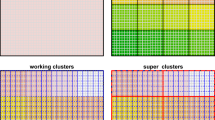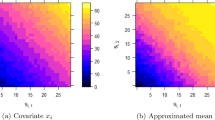Abstract
A methodology for estimating environmental thresholds of binary presence–absence data is presented where the level of the threshold is parameterised. Presence–absence data is fitted to three complementary different models: an independent null-model, a monotonically increasing or decreasing model, and an optimum model. The range of the three models is strictly between zero and one and the models are therefore well suited for modelling presence probabilities. The results of the three models may be combined by using Bayesian model selection methodologies. The proposed methodology is exemplified on observed binary presence–absence data of Bauera rubioides along an elevation gradient.
Similar content being viewed by others
References
MP Austin (1985) ArticleTitleContinuum concept, ordination methods, and niche theory Annu Rev Ecol Syst 16 39–61 Occurrence Handle10.1146/annurev.es.16.110185.000351
MP Austin (2002) ArticleTitleSpatial prediction of species distribution: an interface between ecological theory and statistical modelling Ecol Model 157 101–118 Occurrence Handle10.1016/S0304-3800(02)00205-3
MS Boyce LL McDonald (1999) ArticleTitleRelating populations to habitats using resource selection functions Trends Ecol Evol 14 268–272 Occurrence Handle10370262 Occurrence Handle10.1016/S0169-5347(99)01593-1
BP Carlin TA Louis (1996) Bayes and empirical Bayes methods for data analysis Chapman & Hall London
C Damgaard (1998) ArticleTitlePlant competition experiments: testing hypotheses and estimating the probability of coexistence Ecology 79 1760–1767 Occurrence Handle10.2307/176794
C Damgaard (2003) ArticleTitleModelling plant competition along an environmental gradient Ecol Model 170 45–53 Occurrence Handle10.1016/S0304-3800(03)00299-0
C Damgaard R Hjer M Bayley JJ Scott-Fordsman M Holmstrup (2002) ArticleTitleDose-response curve modelling of excess mortality caused by two forms of stress Environ Ecol Stat 9 195–200 Occurrence Handle10.1023/A:1015174205385
HG Gauch RH Whittaker (1972) ArticleTitleCoenocline simulation Ecology 53 446–451 Occurrence Handle10.2307/1934231
HA Gleason (1939) ArticleTitleThe individualistic concept of the plant association Am Midland Nat 21 92–110 Occurrence Handle10.2307/2420377
PJ Green (1995) ArticleTitleReversible jump Markov chain Monte Carlo computation and Bayesian determination Biometrika 82 711–732 Occurrence Handle10.2307/2337340
P Grime (2001) Plant strategies, vegetation processes, and ecosystem properties Wiley New york
E Heegaard (2002) ArticleTitleThe outer border and central border for species-environmental relationships estimated by non-parametric generalised additive models Ecol Model 157 131–139 Occurrence Handle10.1016/S0304-3800(02)00191-6
J Huisman H Olff LFM Fresco (1993) A hierarchical set of models for species response analysis. J Veg Sci 4 37–46
M Kirkpatrick NH Barton (1997) ArticleTitleEvolution of species range Am Nat 150 1–23 Occurrence Handle10.1086/286054
PR Minchin (1989) ArticleTitleMontane vegetation of the Mt. Field massif, Tasmania: a test of some hypotheses about properties of community patterns Vegetatio 83 97–110 Occurrence Handle10.1007/BF00031683
J Oksanen PR Minchin (2002) ArticleTitleContinuum theory revisited: what shape are species responses along ecological gradients? Ecol Model 157 119–129 Occurrence Handle10.1016/S0304-3800(02)00190-4
M Rees PJ Grubb D Kelly (1996) ArticleTitleQuantifying the impact of competition and spatial heterogeneity on the structure and dynamics of a four-species guild of winter annuals Am Nat 147 1–32 Occurrence Handle10.1086/285837
M Rees R Condit M Crawley S Pacala D Tilman (2001) ArticleTitleLong-term studies of vegetation dynamics Science 293 650–655 Occurrence Handle11474101 Occurrence Handle1:CAS:528:DC%2BD3MXls1Kgs7g%3D Occurrence Handle10.1126/science.1062586
G Schwarz (1978) ArticleTitleEstimating the dimension of a model Ann Stat 6 461–464
DJ Spiegelhalter NG Best BP Carlin A Linde Particlevan der (2002) ArticleTitleBayesian measures of model complexity and fit J Roy Stat Soc B 64 583–639 Occurrence Handle10.1111/1467-9868.00353
LA Turnbull D Coomes A Hector M Rees (2004) ArticleTitleSeed mass and the competition/colonization trade-off: competitive interactions and spatial patterns in a guild of annual plants J Eco 92 97–109
S Wolfram (2003) Mathematica Wolfram Research, Inc. Champaign, USA
Author information
Authors and Affiliations
Corresponding author
Additional information
Received: May 2005 / Revised: July 2005
An erratum to this article is available athttp://dx.doi.org/10.1007/s10651-006-0023-7.
Rights and permissions
About this article
Cite this article
Damgaard, C. Modelling Ecological Presence–absence Data along an Environmental Gradient: Threshold Levels of the Environment. Environ Ecol Stat 13, 229–236 (2006). https://doi.org/10.1007/s10651-005-0004-2
Issue Date:
DOI: https://doi.org/10.1007/s10651-005-0004-2




